Construction is a vital industry that fuels economic growth, but it also contributes significantly to environmental degradation. The construction industry generates a massive amount of waste – up to 40% of the world’s total waste. It is time to address this issue and embrace the concept of zero-waste construction sites.
Zero-waste construction sites aim to reduce waste generation, promote resource efficiency and utilize sustainable building practices. By adopting waste reduction techniques, the circular economy concept, and green building materials, construction projects can minimize their impact on the environment and promote a more sustainable future.
Key Takeaways:
- The construction industry generates a significant amount of waste
- Zero-waste construction sites aim to reduce waste and promote sustainable building practices
- The circular economy concept and green building materials are essential for zero-waste construction sites
The Need for Zero-Waste Construction Sites
The construction industry is a major contributor to global waste generation, with estimates suggesting it creates up to 40% of the world’s total waste. Construction waste can have severe environmental consequences, from soil and water pollution to habitat destruction and climate change. As such, there is an urgent need to address the issue of construction waste by adopting sustainable building practices and implementing zero-waste construction sites.
Proper construction waste management is crucial to mitigate the impact of construction waste on the environment. This includes reducing waste generation, reusing materials, and recycling where possible. A zero-waste approach takes these principles further by aiming to eliminate waste altogether, which can result in significant environmental and economic benefits.
Zero-waste construction sites can have a positive impact on the environment by reducing landfill waste, conserving natural resources, and reducing greenhouse gas emissions. In addition, adopting sustainable building practices can lead to cost savings, improved resource efficiency, and enhanced reputation for construction companies.
The Need for Zero-Waste Construction Sites
Construction waste is a growing concern, leading to environmental issues such as soil and water pollution, habitat destruction, and climate change. Proper management and reduction of construction waste are crucial to alleviate these negative impacts. Implementing zero-waste construction sites can further reduce the environmental footprint of the construction industry and promote sustainable building practices.
By adopting zero-waste practices, construction companies can reduce the amount of waste generated on-site, reuse materials, and recycle where possible. This can have a significant positive impact on the environment, including reducing landfill waste, conserving natural resources, and lowering greenhouse gas emissions.
In addition to the environmental benefits, implementing zero-waste practices can also lead to cost savings, improved resource efficiency, and enhanced reputation for construction companies. By adopting sustainable building practices, construction companies can set themselves apart from competitors and demonstrate their commitment to a more eco-friendly future.

Key Principles of Zero-Waste Construction
Zero-waste construction aims to eliminate waste generation and maximize resource efficiency. The key principles behind zero-waste construction include:
| Principle |
Description |
| Source Reduction |
Minimizing waste generation by reducing the amount of materials used and optimizing designs to eliminate waste. |
| Reusing Materials |
Reusing building materials that are still in good condition, such as doors, windows, and structural components. |
| Recycling Materials |
Recycling materials that cannot be reused, such as concrete and steel, to reduce the amount of waste sent to landfills. |
| Composting Biodegradable Waste |
Composting biodegradable waste such as wood, paper, and food scraps to produce nutrient-rich soil amendments. |
| Collaboration and Communication |
Building strong partnerships among all stakeholders to share information, coordinate efforts, and ensure effective implementation of waste reduction strategies. |
By applying these principles, construction sites can dramatically reduce their environmental impact and achieve a more sustainable future. According to a report by the Ellen MacArthur Foundation, adopting circular economy principles in the construction industry could lead to a reduction in global carbon emissions of up to 44% by 2050.
Implementing these principles involves a shift in mindset and a willingness to embrace change. However, the benefits of zero-waste construction are clear and far-reaching, making it an essential component of any sustainable construction project.
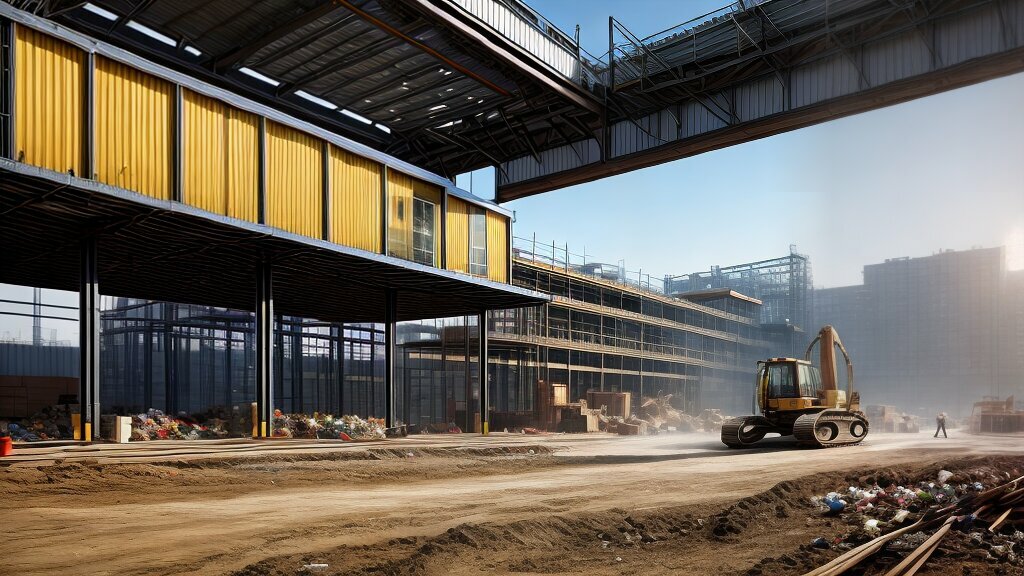
Case Studies: Successful Zero-Waste Construction Sites
To showcase the feasibility of implementing zero-waste practices in construction, let’s take a look at some real-life case studies:
1. The Edge, Amsterdam
The Edge is a landmark building in Amsterdam that has achieved the highest BREEAM rating ever recorded, thanks to its innovative design and sustainability features. The building’s construction followed a rigorous waste management plan, with materials either reused on-site or recycled if possible. The use of smart technologies for lighting, ventilation, and energy management further reduced the building’s environmental impact. The result is a stunning, energy-efficient building that has won numerous awards and serves as a shining example of sustainable construction practices.
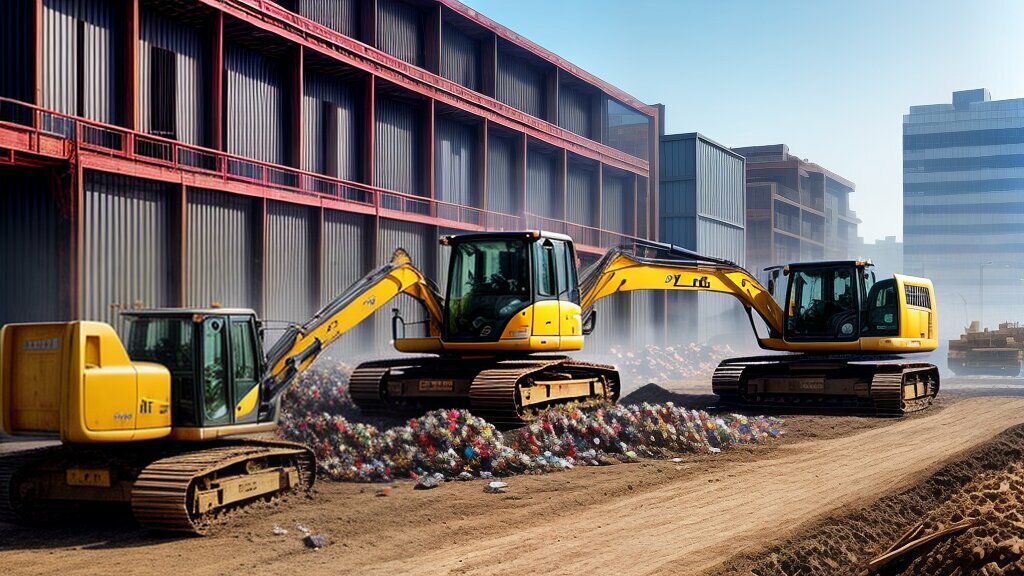
2. Green Square Complex, Australia
The Green Square Complex in Sydney, Australia, is an ambitious redevelopment project that aims to become a zero-carbon, zero-waste community. The construction process followed a strict waste management plan, with all waste materials sorted and separated for reuse or recycling. The use of renewable energy sources, such as solar panels and geothermal energy, further reduced the building’s carbon footprint. As a result, the Green Square Complex is a vibrant, sustainable community that sets a new standard for eco-friendly construction.
3. The Bullitt Center, Seattle
The Bullitt Center in Seattle, USA, is a six-story office building that is widely recognized as one of the greenest buildings in the world. The building’s construction followed a rigorous waste management plan, with all materials carefully selected for their eco-friendliness and durability. The design includes features such as rainwater harvesting, solar panels, and a composting system. The result is a beautiful, energy-efficient building that uses 83% less energy than a typical office building and generates more energy than it consumes.
“The use of innovative technologies, waste reduction techniques, and sustainable building practices are key to achieving zero-waste construction sites.”
4. HouseZero, Cambridge
HouseZero is a retrofitted building in Cambridge, Massachusetts, that has been transformed into a zero-energy, zero-carbon building. The project involved the extensive use of sustainable building materials, such as cellulose insulation and triple-paned windows, as well as the implementation of innovative technologies, such as a radiant cooling system and a geothermal heat pump. The waste management plan involved the segregation of waste materials, with all recyclable materials sent to local recycling facilities. The result is a stunning, sustainable building that sets a benchmark for future retrofitted developments.
These case studies demonstrate that zero-waste construction sites are not only feasible but also economically and environmentally advantageous. By implementing sustainable building practices, construction companies can reduce waste generation, cut costs, and enhance their reputation as leaders in eco-friendly construction.
Sustainable Construction Practices for Zero-Waste Sites
In order to achieve zero-waste goals, a range of sustainable construction practices can be implemented to minimize waste generation. One key aspect of sustainable construction is the use of green building materials. These materials are environmentally friendly and provide a more sustainable alternative to traditional building materials. For example, recycled steel, bamboo, and straw bales can be used for structural components, while low VOC paints and adhesives can be used for finishing touches. Using these materials not only reduces waste but also helps to improve indoor air quality.
Another important aspect of sustainable construction is energy-efficient design. Incorporating features such as double-glazed windows, insulation, and efficient heating and cooling systems can significantly reduce energy consumption and costs. Renewable energy sources such as solar panels and wind turbines can also be integrated into the design to provide clean and sustainable energy.
When planning a construction project, it is important to consider the entire life cycle of the building. This involves assessing the environmental impact of materials and products used during construction, as well as their potential for reuse or recycling at the end of the building’s life. Environmental certifications such as LEED (Leadership in Energy and Environmental Design) can be used to ensure that the building meets certain sustainability standards.

Overall, sustainable construction practices play a vital role in achieving zero-waste goals on construction sites. By using green building materials, designing for energy efficiency, and considering the full life cycle of the building, waste generation can be minimized and resource efficiency can be maximized.
Waste Management Strategies and Technologies
In order to achieve zero-waste construction sites, it is crucial to implement effective waste management strategies and technologies. This involves a combination of reducing waste generation, segregating waste, recycling, and responsible disposal practices.
One strategy is to implement an on-site material sorting system. This involves separating materials at the source to ensure that recyclable materials are diverted from the landfill. Another way to reduce waste generation is to use prefabricated construction components, which minimize the amount of waste generated during on-site construction.
Recycling is an essential component of zero-waste construction sites. This involves separating and processing waste materials such as concrete, wood, metal, and plastics, and reusing them in construction projects. Additionally, adopting circular economy concepts can help to reduce waste by promoting the reuse and repurposing of materials.
Innovative technologies such as waste-to-energy systems are also gaining popularity. These systems convert waste into usable energy, reducing the reliance on non-renewable energy sources. However, it is important to consider the environmental impact and life cycle assessment of such technologies before implementing them on construction sites.
Ultimately, effective waste management strategies and technologies require collaboration and education among all stakeholders, including contractors, subcontractors, suppliers, and workers. By working together and implementing responsible waste management practices, zero-waste construction sites can become a reality.
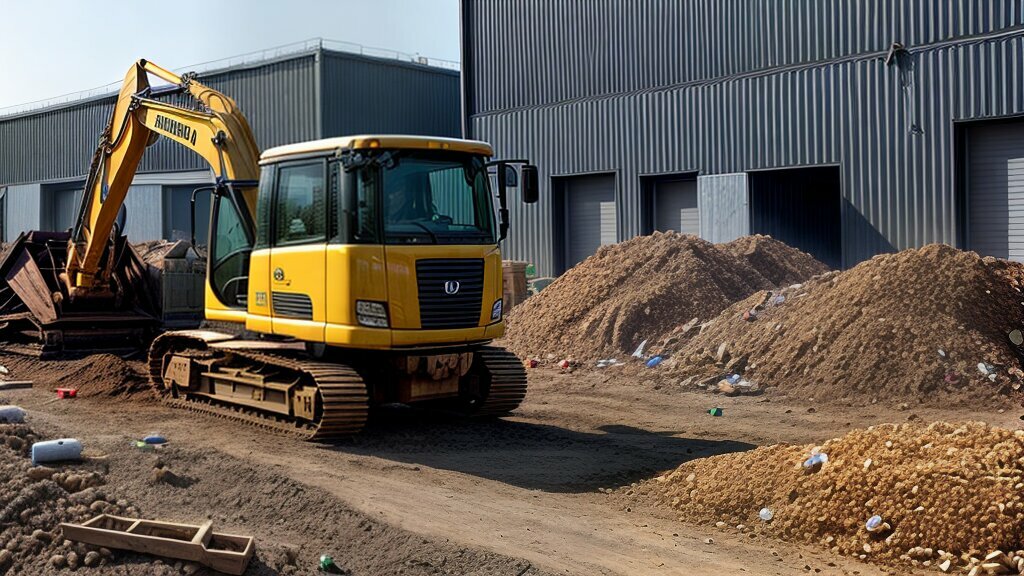
Engaging Stakeholders in Zero-Waste Construction
Engaging all stakeholders is crucial for achieving zero-waste construction sites. This includes contractors, subcontractors, suppliers, and workers. Everyone involved in the project should be aware of the sustainability goals and the importance of waste reduction techniques.
One way to engage stakeholders is to provide training and education on sustainable construction practices. This can include information on waste reduction techniques, recycling in construction, and the circular economy concept. Workers and contractors should be encouraged to share their ideas and suggestions for improving sustainability on the worksite.
Another effective strategy is to create incentives for engaging in sustainable practices. Financial rewards, recognition, and performance evaluations can motivate stakeholders to prioritise waste reduction and sustainability.
| Tip: |
Hold regular meetings and open forums to discuss sustainable practices and answer questions. Encourage everyone to share their thoughts and concerns about waste reduction and sustainability. |
Transparency and clear communication are also vital for engaging stakeholders. All parties involved in the project should be informed of the sustainability goals, progress, and challenges. Transparency can help to build trust and support for the sustainability initiatives.
A successful waste reduction plan requires a collaborative effort from all stakeholders. By engaging everyone in the project and promoting awareness, we can achieve zero-waste construction sites and contribute to a more sustainable future.

Benefits of Implementing Zero-Waste Practices
Implementing zero-waste practices in construction projects offers numerous benefits for both the environment and the bottom line. Here are some of the key advantages:
| Environmental Impact |
Zero-waste construction sites significantly reduce the amount of waste that ends up in landfills and the associated environmental pollution and greenhouse gas emissions. Using sustainable building practices such as green materials and energy-efficient designs also reduces the carbon footprint of the construction process. Implementing these practices promotes a more sustainable future for all. |
| Cost Savings |
By minimizing waste generation and optimizing resource efficiency, zero-waste practices can save construction companies money. This approach can reduce material costs, transport expenses, and disposal fees. It can also increase the lifespan of materials and equipment, ultimately leading to significant cost savings. |
| Improved Resource Efficiency |
By applying the principles of the circular economy, zero-waste construction sites aim to close the resource loop by reusing and recycling materials. This not only reduces waste but also conserves natural resources and energy. Implementing sustainable building practices, such as using green materials, also reduces the consumption of non-renewable resources, such as fossil fuels, and saves costs related to raw materials. |
| Enhanced Reputation |
Construction companies that prioritize sustainability and zero-waste initiatives can enhance their reputation and attract environmentally conscious clients. Adopting eco-friendly construction practices can help companies become leaders in their industries, setting them apart from competitors. |
Overall, implementing zero-waste practices in construction projects offers numerous benefits that contribute to a more sustainable future. By prioritizing environmental responsibility, cost savings, resource efficiency, and reputation, construction companies can achieve long-term success in a rapidly changing industry. Image source: 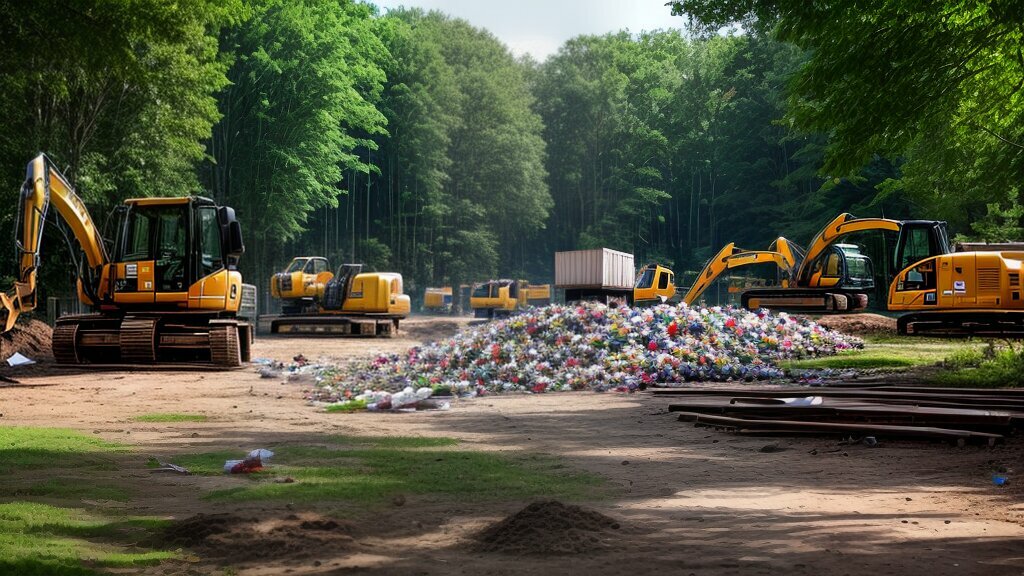
Overcoming Challenges and Barriers
Although the benefits of zero-waste construction sites are clear, implementing sustainable building practices can still pose challenges and barriers. One of the main obstacles is resistance to change. Some construction professionals may be hesitant to adopt new practices and technologies, fearing disruptions to their established workflows.
To overcome this challenge, it’s important to involve all stakeholders in the planning and implementation process. Clear communication and collaboration can help build support for waste reduction techniques and foster a sense of ownership among team members.
In addition, lack of awareness and education can be barriers to implementing sustainable construction practices. To address this, it’s important to provide training and resources that educate workers and contractors about the benefits of zero-waste practices and how to implement them effectively. By building knowledge and understanding, construction teams can become motivated to embrace sustainable practices and overcome any initial reluctance.

Technical limitations can also present challenges to zero-waste construction sites. For example, some materials may not be easily recyclable or may not have sustainable alternatives available yet. In these cases, it’s important to find creative solutions and work with partners who can help identify viable options. In addition, it’s important to continuously monitor and evaluate waste management strategies to identify areas for improvement and stay ahead of emerging technologies.
Overcoming challenges and barriers to zero-waste construction sites requires patience, persistence, and a commitment to sustainability. By fostering collaboration, building awareness, and finding innovative solutions, construction professionals can work together to build a more sustainable future.
Future Trends and Innovations
In recent years, there has been a growing emphasis on sustainability in the construction industry. As a result, new trends and innovations are emerging that support the development of zero-waste construction sites.
One such trend is the use of biodegradable building materials, such as hempcrete, mycelium, and bamboo. These materials have a low environmental impact and can be easily recycled or composted at the end of their life cycle.
The emergence of 3D printing technology is also set to transform the construction industry. It allows for the creation of precise, customised components with minimal waste generation. This technology has the potential to revolutionise the way that buildings are designed and constructed.
The circular economy is another concept that is gaining traction in the construction industry. It involves designing buildings and products with a focus on resource efficiency and waste reduction. The goal is to create a closed-loop system where materials are continuously circulated through the economy without creating waste.
Finally, the use of augmented reality (AR) and virtual reality (VR) is becoming increasingly popular in the construction industry. These technologies can help architects and builders visualise projects in 3D, identify potential design flaws, and optimise resource use.
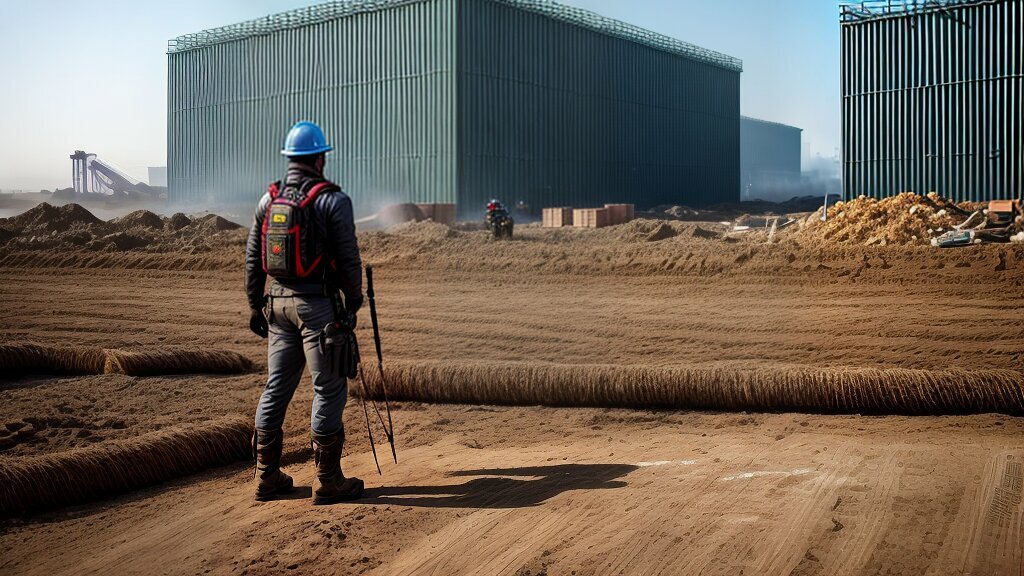
As these and other innovations continue to develop, the construction industry will become more sustainable, efficient, and eco-friendly. By embracing zero-waste practices and sustainable building techniques, we can create a better future for ourselves and the planet.
Conclusion
Zero-waste construction sites are the future of the construction industry, and implementing sustainable building practices is crucial for a more eco-friendly future. By adopting waste reduction techniques and embracing circular economy principles, construction projects can minimize waste generation and maximize resource efficiency.
Real-life case studies have shown that zero-waste construction sites are not only achievable but also cost-effective, environmentally friendly, and socially responsible. However, achieving zero-waste goals requires the engagement and collaboration of all stakeholders, including contractors, subcontractors, suppliers, and workers.
Join the Movement
We urge our readers to embrace and advocate for zero-waste practices in their construction projects. Sustainable building practices not only benefit the environment but also enhance a company’s reputation and can result in significant cost savings.
By prioritizing sustainable building practices, we can create a more resilient and sustainable future for ourselves and generations to come. Stay informed about emerging trends and innovations in the construction industry that support the development of zero-waste construction sites.
Together, we can achieve zero-waste construction sites and create a better world for all.
FAQ
Q: What are zero-waste construction sites?
A: Zero-waste construction sites are construction projects that aim to minimize waste generation and maximize resource efficiency. They employ sustainable practices and innovative techniques to reduce, reuse, and recycle materials throughout the construction process.
Q: Why is it important to implement sustainable practices in the construction industry?
A: Implementing sustainable practices in the construction industry is important to minimize the negative environmental impacts associated with construction activities. It helps reduce waste generation, conserve resources, and promote the use of eco-friendly materials and technologies.
Q: What are waste reduction techniques in the construction industry?
A: Waste reduction techniques in the construction industry involve strategies to minimize waste generation, such as efficient material management, recycling programs, and responsible disposal practices. These techniques help to reduce the overall environmental impact of construction projects.
Q: What is the circular economy concept in construction?
A: The circular economy concept in construction involves designing, building, and operating buildings in a way that maximizes resource efficiency and minimizes waste. It focuses on the reuse, recycling, and repurposing of materials to create a more sustainable and circular construction industry.
Q: What are green building materials?
A: Green building materials are eco-friendly materials that are used in construction projects. They are sourced sustainably, have a low environmental impact, and contribute to the overall energy efficiency and sustainability of buildings.
Q: Why is proper construction waste management important?
A: Proper construction waste management is important to minimize the negative impacts of construction activities on the environment. It helps reduce pollution, conserve resources, and promote the responsible handling and disposal of construction waste.
Q: What are the key principles of zero-waste construction?
A: The key principles of zero-waste construction include waste reduction techniques and the application of the circular economy concept. These principles focus on minimizing waste generation, promoting resource efficiency, and maximizing the reuse and recycling of materials.
Q: Can you provide examples of zero-waste construction projects?
A: Yes, there are several real-life case studies of construction sites that have successfully implemented zero-waste practices. These projects have showcased the feasibility and benefits of going zero-waste in construction, highlighting strategies used, challenges faced, and outcomes achieved.
Q: What are sustainable construction practices for zero-waste sites?
A: Sustainable construction practices for zero-waste sites include the use of green building materials, energy-efficient designs, and renewable energy sources. It also involves considering life cycle assessments and environmental certifications in construction projects to minimize environmental impact.
Q: What waste management strategies and technologies are employed on zero-waste construction sites?
A: Waste management strategies and technologies employed on zero-waste construction sites include waste segregation, recycling programs, and responsible disposal practices. Innovative technologies such as on-site material sorting and waste-to-energy systems are also used to promote sustainable waste management.
Q: How can stakeholders be engaged in zero-waste construction?
A: Engaging stakeholders in zero-waste construction involves promoting awareness and encouraging participation in waste reduction techniques. This includes contractors, subcontractors, suppliers, and workers, and requires collaboration and clear communication throughout the construction process.
Q: What are the benefits of implementing zero-waste practices in construction?
A: Implementing zero-waste practices in construction projects has numerous benefits, including a positive environmental impact, cost savings, improved resource efficiency, and an enhanced reputation for sustainable building practices.
Q: What challenges and barriers may arise when implementing zero-waste practices in construction?
A: When implementing zero-waste practices in construction, challenges and barriers such as resistance to change, lack of awareness, and technical limitations may arise. Strategies and solutions can be employed to overcome these obstacles and ensure successful implementation.
Q: What are the future trends and innovations in zero-waste construction?
A: Future trends and innovations in zero-waste construction include advancements in materials, technologies, and design approaches that contribute to the circular economy. Staying informed about industry developments is important to leverage these trends and innovations in construction projects.
Q: What is the conclusion of zero-waste construction sites?
A: The conclusion of zero-waste construction sites emphasizes the importance of sustainable building practices and the benefits of implementing zero-waste practices. It encourages readers to embrace and advocate for zero-waste practices in their own construction projects to contribute to a more sustainable future.



























Post comments (0)